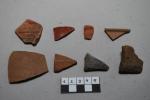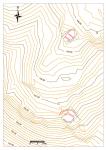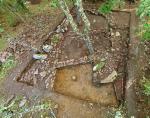Summary (English)
Several sondages were conducted in this large 59 hectare archaeological site. In the area called El Cañaveral in particular, a 63 m2 sondage and other 40 m2 were conducted. They allowed the identification of two housees. Both were formed of double-thick walls, filled with tegulae, stones and soil, and granite socles. Both structures formed part of a little settlement located I the area of El Cañaveral, integrated in a group of similar settlements, built around the stream “Mazo de Prado Álvaro”.
The first one of these sondages (3) allowed observation of a 25 m2 oval structure, characterized by the use of large granite slabs as flooring (UE 312), as well as the presence of reused ashlar stones (UE 301). Chronology for the use of this structure derives from pottery: kitchenware with mixed or reduction firing is plentiful. There are also some fragments of thin-walled refined clay, compacted without the use of temper, and fired in an oxidizing atmosphere. They may be dated between the 5th and 7th centuries AD. Although all this material must be dated between the 5th and the 7th centuries AD, it could belong to a longer period. Nevertheless, ceramic ware belonging to an earlier period has also been recovered (a Drag. 36 rim, and other sherds dating to the 1st-2nd centuries AD). Together with the ashlar stones, these materials seem to have been taken from a nearby site and reused.
25 m NW of the previous sondage, the second one (Sondage 4), unearthed a structure with an oval floor plan built with a similar technique to the previous one (UUEE 401 y 402). This drilling recovered mainly kitchen and storage ware, with identical characteristics to the ones described previously.. It could therefore be said that the occupation dates to the 5th-7th centuries AD, a fact proved by the two structures that possibly belonged to a rural settlement. However, a previous occupation stage was also documented, characterized by the presence of a series of 35 cm high, dry masonry walls, built with irregular granite blocks of different sizes (UUEE 403, 411 y 415). They form a SW-NE oriented orthogonal structure, associated to a series of floors. These walls were filled in post-Roman construction. The existence of some Sigillata (a Drag. 36 plate [409/1], dating to the 1st-2nd centuries AD, and another Hisp. 15/17 plate, dating to the 2nd-3rd AD [409/3]) and some dolium sherds seem to indicate an Early Roman Empire occupation (1st-3rd century AD).
Furthermore, the whole sector of the stream “Mazo de Prado Álvaro” had been previously surveyed. A total of 19 tombs carved into the rock were identified. Chronology of this kind of burials remains unclear, but it might be dated between the 7th and the 11th centuries. During survey works undertaken at the same time as the excavation two more tombs of the same kind were documented, one of them 17 m away from the structure of Sondage 4. In conclusion, we consider that the structures at “El Cañaveral” and the tomb form a whole that could be dated around the 7th century.
(translation by Laura González Fernández)
- Iñaki Martín Viso
Director
- Iñaki Martín Viso (Universidad de Salamanca)
- Rubén Rubio Diez (Arqueólogo profesional)
Team
- Alicia Álvarez; Marisa Bueno; Álvaro Carvajal; Silvia Casimiro; Marta Crespo; Tomás Cordero; José Fabián Cuesta; Rodrigo Garnelo; Franciso Javier González; Francisco Javier Marcos; Tiago Pereira; Sara Prata; Marina Afonso Vieira
- Laura Cabanillas; David Fernández; Sonsoles Fernández; Rubén García; Lucía Muñoz; María Pérez; Pablo Poveda; Catarina Mateus Soares; Leticia Tobalina
Research Body
- Universidad de Salamanca
Funding Body
- Secretaría de Estado de Investigación, Desarrollo e Innovación, Secretaría General de Ciencia, Tecnología e Innovación. Dirección General de Investigación Científica y Técnica, Ministerio de Economía y Competitividad, Gobierno de España






![Download [PDF]](/excavation/skins/fasti/images/results/download_sml.png)


